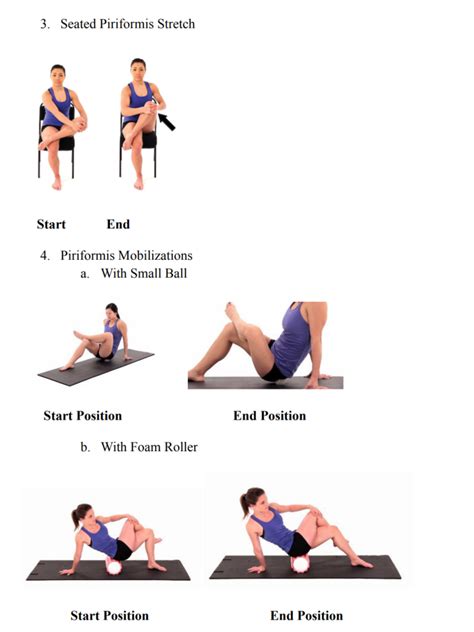The piriformis muscle, located in the buttock region, plays a crucial role in hip and leg movement. However, when this muscle becomes tight or inflamed, it can lead to discomfort and pain, commonly known as piriformis syndrome. One of the most effective ways to alleviate this pain is through stretching exercises, which can be done while sitting. Here, we’ll delve into 12 sitting piriformis stretches that you can incorporate into your daily routine for relief.
Understanding Piriformis Syndrome
Before we dive into the stretches, it’s essential to understand what piriformis syndrome is. This condition occurs when the piriformis muscle, which runs from the base of the spine to the thighbone, compresses or irritates the sciatic nerve. This irritation can cause pain, numbness, and tingling in the buttocks and along the path of the sciatic nerve, which travels down the back of the leg. Sitting for long periods can exacerbate this condition, making it crucial to incorporate stretches that can be done from a seated position.
The Importance of Sitting Stretches
Sitting stretches are particularly beneficial for individuals who have jobs that require prolonged sitting or for those who spend a lot of time driving. These stretches can help prevent the onset of piriformis syndrome or provide relief if you’re already experiencing symptoms. The beauty of these stretches is that they can be done anywhere, at any time, without needing to leave your seat.
12 Sitting Piriformis Stretches for Relief
1. Seated Piriformis Stretch
- How to do it: Sit on the floor with the affected leg crossed over your other leg. Place your hand on the knee of the crossed leg and pull it toward your opposite shoulder. You should feel a stretch in the buttock area. Hold for 30 seconds and then switch legs.
- Why it works: This stretch targets the piriformis muscle directly, helping to relieve tension and pressure on the sciatic nerve.
2. Figure 4 Stretch
- How to do it: While sitting, cross the affected leg over your other leg, forming a “figure 4” shape. Place your ankle on the opposite knee and gently press down on the knee of the crossed leg to deepen the stretch. Hold for 30 seconds and then switch legs.
- Why it works: Similar to the seated piriformis stretch, this position helps to loosen the piriformis muscle and reduce pressure on the sciatic nerve.
3. Seated Twist
- How to do it: Sit with your feet on the floor or on a footrest, if needed. Twist your torso to one side, keeping your feet and hips facing forward. Hold onto the armrest or seat for support if necessary. Hold for 30 seconds and then twist to the other side.
- Why it works: Twisting helps to stretch the muscles in your lower back and buttocks, which can help relieve tension in the piriformis muscle.
4. Seated Forward Fold
- How to do it: Slowly lean forward while seated, reaching for your toes. Keep your knees slightly bent if necessary. Hold for 30 seconds.
- Why it works: This stretch targets the entire back side of your leg, from the buttocks down to the calf, and can help reduce tension in the piriformis muscle.
5. Buttock Stretch
- How to do it: Sit on the edge of a chair with one leg stretched out behind you and the other foot on the floor in front of you. Lean forward, bending at the waist, until you feel a stretch in your buttock. Hold for 30 seconds and then switch legs.
- Why it works: This position allows for a deep stretch in the buttock area, directly targeting the piriformis muscle.
6. Seated Leg Stretch
- How to do it: Sit with your affected leg straight out in front of you. Lean forward, reaching for your toes, until you feel a stretch in the back of your leg. Hold for 30 seconds and then switch legs.
- Why it works: Similar to the seated forward fold, this stretch targets the muscles in the back of the leg and buttocks, helping to relieve tension in the piriformis muscle.
7. Piriformis Stretch with Belt
- How to do it: Sit on the floor with the affected leg crossed over your other leg. Loop a towel or belt around the ball of the foot on the crossed leg and gently pull your knee toward your opposite shoulder. Hold for 30 seconds and then switch legs.
- Why it works: Using a belt or towel can help deepen the stretch and provide more leverage in stretching the piriformis muscle.
8. Seated Pigeon Stretch
- How to do it: Sit with your affected leg bent in front of you, with your foot resting on the floor beside your knee. Place your hand on the knee of the bent leg and gently press down to deepen the stretch. Hold for 30 seconds and then switch legs.
- Why it works: This stretch targets the piriformis muscle and the surrounding hip area, helping to improve flexibility and reduce pain.
9. Ankle circulation exercises
- How to do it: Sit comfortably and lift your legs off the floor, keeping them straight. Rotate your ankles in both clockwise and counterclockwise directions. Repeat for several repetitions.
- Why it works: While not directly stretching the piriformis, improving circulation can help reduce muscle tension and promote healing.
10. Toe Wiggles
- How to do it: Sit with your feet on the floor. Wiggle your toes back and forth, spreading them apart as far as you can and then bringing them together. Repeat for several repetitions.
- Why it works: Similar to ankle rotations, toe wiggles can help improve circulation and reduce tension in the feet and legs, which can indirectly benefit the piriformis muscle.
11. Seated Hip Abduction
- How to do it: Sit with your feet together. Slowly lift one leg out to the side, keeping it straight, until you feel a stretch in your hip and buttock area. Hold for a few seconds and then lower your leg back down. Repeat on the other side.
- Why it works: This exercise helps strengthen the muscles around the hip and can help stabilize the piriformis muscle, reducing the risk of irritation.
12. Buttock Squeezes
- How to do it: Sit comfortably and squeeze your buttock muscles together. Hold for a few seconds and then release. Repeat for several repetitions.
- Why it works: Strengthening the buttock muscles can help support the piriformis muscle and improve overall hip stability, reducing the risk of piriformis syndrome.
Frequently Asked Questions
How often should I do these stretches to see relief from piriformis syndrome?
+It's recommended to do these stretches at least 2-3 times a day, holding each stretch for 30 seconds. Consistency is key when it comes to seeing relief from piriformis syndrome. Gradually increase the frequency and duration as your body becomes more flexible and comfortable with the stretches.
Can I do these stretches if I have a severe case of piriformis syndrome?
+While these stretches are beneficial, if you have a severe case of piriformis syndrome, it's advisable to consult with a healthcare professional or physical therapist before starting any new exercise routine. They can provide personalized advice and modifications to ensure your safety and effectiveness of the stretches.
How long does it take to see improvement in piriformis syndrome symptoms through stretching?
+Improvement in piriformis syndrome symptoms through stretching can vary from person to person. Some may experience relief within a few days to a week, while others may take several weeks to notice significant improvements. It's essential to be patient, consistent, and to combine stretching with other health practices such as regular exercise, proper posture, and a balanced diet.
Are there any other methods besides stretching to relieve piriformis syndrome?
+Yes, besides stretching, other methods to relieve piriformis syndrome include physical therapy, foam rolling, heat or cold therapy, and in some cases, medical intervention such as steroid injections or surgery for severe cases. Lifestyle changes such as maintaining a healthy weight, avoiding prolonged sitting, and engaging in regular physical activity can also help manage symptoms.
Can piriformis syndrome be prevented?
+While some cases of piriformis syndrome may not be preventable, many instances can be prevented or the risk significantly reduced by maintaining a healthy lifestyle, including regular exercise, proper posture, taking regular breaks when sitting for long periods, and managing weight. Engaging in activities that strengthen the core and gluteal muscles can also help stabilize the piriformis muscle and reduce the risk of syndrome development.
Conclusion
Piriformis syndrome can be a challenging condition to manage, but with the right approach, individuals can find relief and improve their quality of life. Incorporating the 12 sitting piriformis stretches outlined above into your daily routine, along with adopting healthy lifestyle habits, can significantly reduce symptoms and prevent future occurrences. Remember, consistency and patience are key, and it’s always a good idea to consult with healthcare professionals for personalized advice and care.


